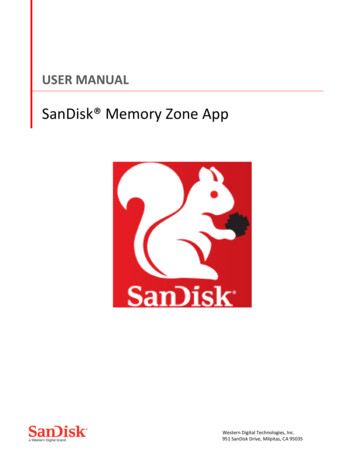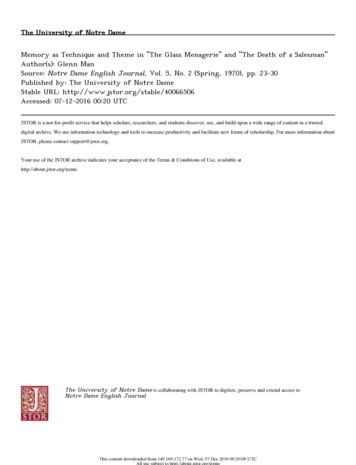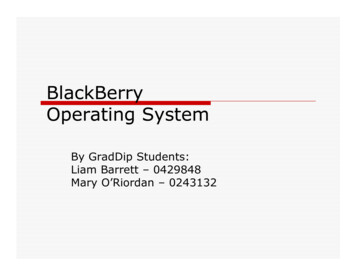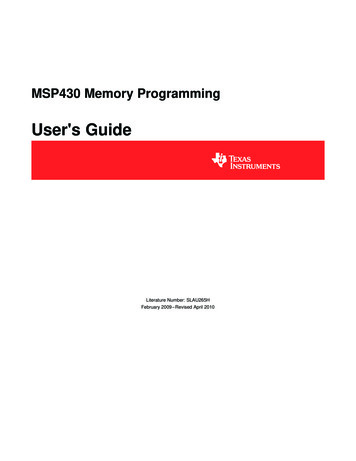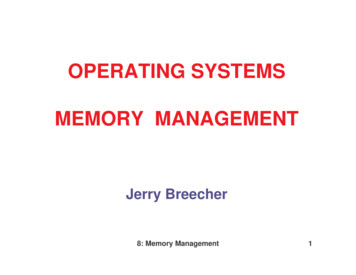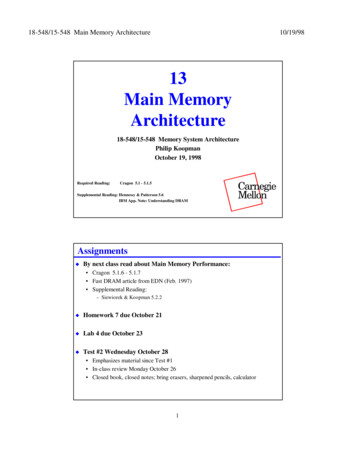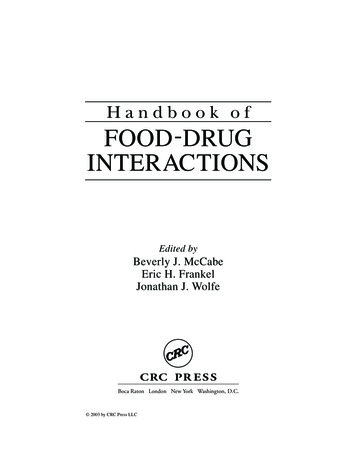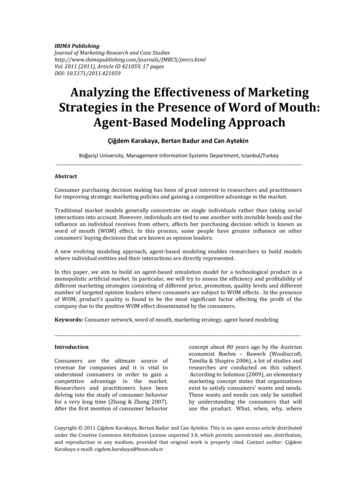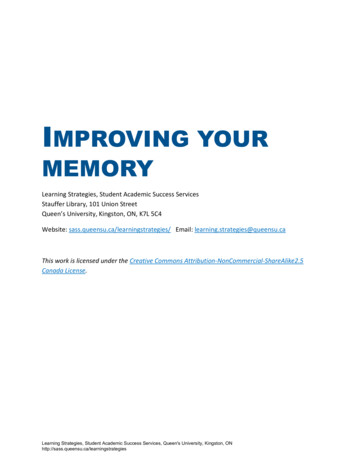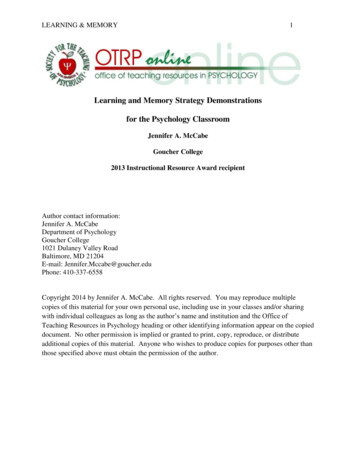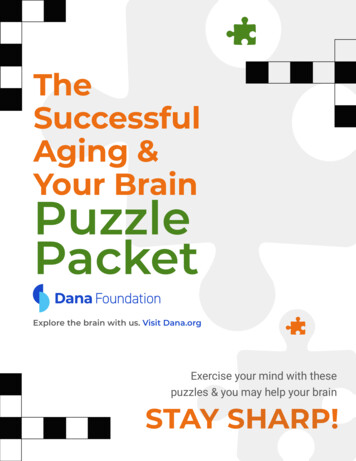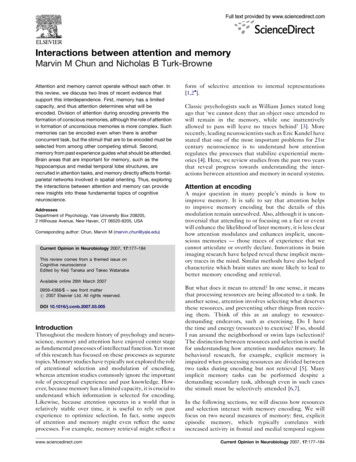
Transcription
Interactions between attention and memoryMarvin M Chun and Nicholas B Turk-BrowneAttention and memory cannot operate without each other. Inthis review, we discuss two lines of recent evidence thatsupport this interdependence. First, memory has a limitedcapacity, and thus attention determines what will beencoded. Division of attention during encoding prevents theformation of conscious memories, although the role of attentionin formation of unconscious memories is more complex. Suchmemories can be encoded even when there is anotherconcurrent task, but the stimuli that are to be encoded must beselected from among other competing stimuli. Second,memory from past experience guides what should be attended.Brain areas that are important for memory, such as thehippocampus and medial temporal lobe structures, arerecruited in attention tasks, and memory directly affects frontalparietal networks involved in spatial orienting. Thus, exploringthe interactions between attention and memory can providenew insights into these fundamental topics of cognitiveneuroscience.AddressesDepartment of Psychology, Yale University Box 208205,2 Hillhouse Avenue, New Haven, CT 06520-8205, USACorresponding author: Chun, Marvin M (marvin.chun@yale.edu)Current Opinion in Neurobiology 2007, 17:177–184This review comes from a themed issue onCognitive neuroscienceEdited by Keiji Tanaka and Takeo Watanabeform of selective attention to internal representations[1,2 ].Classic psychologists such as William James stated longago that ‘we cannot deny that an object once attended towill remain in the memory, while one inattentivelyallowed to pass will leave no traces behind’ [3]. Morerecently, leading neuroscientists such as Eric Kandel havestated that one of the most important problems for 21stcentury neuroscience is to understand how attentionregulates the processes that stabilize experiential memories [4]. Here, we review studies from the past two yearsthat reveal progress towards understanding the interactions between attention and memory in neural systems.Attention at encodingA major question in many people’s minds is how toimprove memory. It is safe to say that attention helpsto improve memory encoding but the details of thismodulation remain unresolved. Also, although it is uncontroversial that attending to or focusing on a fact or eventwill enhance the likelihood of later memory, it is less clearhow attention modulates and enhances implicit, unconscious memories — those traces of experience that wecannot articulate or overtly declare. Innovations in brainimaging research have helped reveal these implicit memory traces in the mind. Similar methods have also helpedcharacterize which brain states are more likely to lead tobetter memory encoding and retrieval.Available online 26th March 20070959-4388/ – see front matter# 2007 Elsevier Ltd. All rights reserved.DOI 10.1016/j.conb.2007.03.005IntroductionThroughout the modern history of psychology and neuroscience, memory and attention have enjoyed center stageas fundamental processes of intellectual function. Yet mostof this research has focused on these processes as separatetopics. Memory studies have typically not explored the roleof attentional selection and modulation of encoding,whereas attention studies commonly ignore the importantrole of perceptual experience and past knowledge. However, because memory has a limited capacity, it is crucial tounderstand which information is selected for encoding.Likewise, because attention operates in a world that isrelatively stable over time, it is useful to rely on pastexperience to optimize selection. In fact, some aspectsof attention and memory might even reflect the sameprocesses. For example, memory retrieval might reflect awww.sciencedirect.comBut what does it mean to attend? In one sense, it meansthat processing resources are being allocated to a task. Inanother sense, attention involves selecting what deservesthese resources, and preventing other things from receiving them. Think of this as an analogy to resourcedemanding endeavors, such as exercising. Do I havethe time and energy (resources) to exercise? If so, shouldI run around the neighborhood or swim laps (selection)?The distinction between resources and selection is usefulfor understanding how attention modulates memory. Inbehavioral research, for example, explicit memory isimpaired when processing resources are divided betweentwo tasks during encoding but not retrieval [5]. Manyimplicit memory tasks can be performed despite ademanding secondary task, although even in such casesthe stimuli must be selectively attended [6,7].In the following sections, we will discuss how resourcesand selection interact with memory encoding. We willfocus on two neural measures of memory: first, explicitepisodic memory, which typically correlates withincreased activity in frontal and medial temporal regionsCurrent Opinion in Neurobiology 2007, 17:177–184
178 Cognitive neuroscienceduring encoding (subsequent memory) [8]; and second,implicit perceptual memory, which is typically revealedby decreased activity in ventral visual cortex when visualstimuli are repeated (known as repetition attenuation,repetition suppression, or functional magnetic resonance[fMR] adaptation) [9 ].Attentional resourcesOne popular way to study attentional effects is to requiresubjects to perform dual tasks. Importantly, the impact ofdividing attention on memory depends on how attentionis divided.Typically, difficult versus easy auditory monitoring tasksimpair memory for words presented at the same time.However, such tasks do not modulate activity in the leftinferior prefrontal cortex (LIPC), which is important forthe encoding of words into long-term memory [10]. Inthat study, a difficult monitoring task reduced encodingrelated activity in dorsolateral prefrontal cortex andsuperior parietal regions, both of which mediate theallocation of cognitive control resources. In other words,the secondary task impaired whether episodic encodingprocesses were engaged or not, while leaving intact theactual encoding processes in the LIPC. Other types ofsecondary tasks can directly affect episodic encodingprocesses if they engage the same LIPC circuitry. Forexample, if required to switch between two incidentalencoding tasks (versus repeating the same task), LIPCactivity increases and memory performance decreases,presumably because task-switching engages the LIPCand interrupts episodic memory formation [11].Although explicit episodic memory might depend on theavailability of cognitive control resources in frontal andparietal regions, the same is not true for implicit perceptual memory. In one study, a highly demandingworking-memory task on face stimuli at fixation hadno effect on parahippocampal place area (PPA)responses to task-irrelevant background scenes [12].When these background scenes were repeated, therewas robust repetition attenuation, suggesting that thescenes were processed and at least briefly retained inperceptual memory. By contrast, repetition attenuationwas eliminated in that study when the perceptual difficulty of the central task was increased. Thus, ‘resources’is not a unitary concept, and the impact of dividingattention will depend on the overlap between the processing demands of the secondary task and the type ofmemory under investigation. This might help to explainstriking demonstrations of perceptual learning for taskirrelevant subliminal stimuli [13]. Interestingly, tasksthat occupy relevant resources are not always deleterious: manipulating items in working memory duringencoding rather than simply rehearsing them increasesdorsolateral prefrontal cortex activity and enhances subsequent episodic memory [14 ].Current Opinion in Neurobiology 2007, 17:177–184The aforementioned studies showed tradeoffs inactivation between regions involved in two differentattention-demanding tasks. However, such tradeoffs arenot restricted to dual-task situations. Even during a singletask, a ‘default’ network of brain regions that are otherwise active during rest become deactivated, revealinganother form of tradeoff [15]. The degree of deactivationis proportional to task difficulty, and thus might reflect theavailability of processing resources [16]. In fact, significant decreases in activity in posterior midline regions,including the posterior cingulate and precuneus, correlatewith better episodic subsequent memory (Figure 1a)[17–19,20 ]. Deactivation in the precuneus and anteriorcingulate cortex is also predictive of repetition attenuation [20 ]. These encoding deactivations seem to reflectthe availability of general attentional resources, becausethey predict subsequent memory under a variety ofencoding and retrieval conditions [19,21 ].Selective attentionJust because you have the resources does not mean thatyou can do everything at once. You still have to choosewhat to do. Likewise, the availability of attentionalresources is not sufficient for memory encoding. Forexample, when faces and scenes are combined into fullyoverlapping composite stimuli (Figure 2), subjects canonly remember what they selectively attend to. Not evenimplicit measures of memory such as repetition attenuation are preserved for ignored stimuli [22 ], even whenrepeated 15 times in a 30 s block [23]. Thus, stimuli thatare to be learned must be selected, whether the task isexplicit or implicit [6,7,24]. (One interesting exception tothis case is the demonstration of low-level perceptuallearning from subthreshold stimuli [13]. However, evensuch cases of visual perceptual learning without perception are not fully passive, but require reinforcement froman independent, concurrent task [25,26 ].)Generally speaking, selective attention becomes crucialwhen there is competition between stimuli in theenvironment. This competition can be resolved in manyways: for example, objects are encoded in the lateraloccipital complex (LOC) only if the spatial location inwhich they appear is selected [27], if they appear in a colorthat the subjects are monitoring [28], or if the experimental task requires that responses are based on features ofthe objects [29]. Similarly, during a detection task, facesare encoded in the fusiform face area only if they matchthe identity of a target face [30]. Interestingly, thenecessity of attention might depend on the level ofrepresentation: repetition attenuation is observed in earlyvisual areas even when attention is allocated to a differentspatial scale or to an unoccupied spatial location [31 ,32 ].Supporting this distinction, Seitz and Dinse (in this issue)review current evidence for neural plasticity and perceptual learning of low-level features in the tactile, auditoryand visual modalities from passive, unattended sensorywww.sciencedirect.com
Interactions between attention and memory Chun and Turk-Browne 179Figure 1Correlates of successful encoding related to attention. Subjects were presented with grayscale scenes, and were required to rapidly judgewhether they depicted indoor or outdoor scenes. Scenes were then categorized based on whether they were subsequently remembered in asurprise memory test. (a) Encoding deactivations. The anterior cingulate cortex (ACC) and left precuneus (LPC) were deactivated relative topassive fixation during the presentation of scenes that were later remembered, but not those that were forgotten. Such deactivations might reflectthe reallocation of resources to encoding processes from the default network. (b) Baseline activity. Greater raw fMRI signal in theparahippocampal place area (PPA) right before the appearance of a scene predicted whether that scene would be remembered. This baselinedifference was eliminated by high-pass temporal filtering, and thus might have resulted from variation in low-frequency attentional states.Nevertheless, event-related responses that predicted subsequent memory, as in (a), persisted after high-pass filtering. Thus, encoding success isthe result of both how stimuli are processed and the state of the brain before encoding. Adapted, with permission, from [20 ].stimulation or even direct electrical or magnetic stimulation of sensory cortices.How does selective attention enhance repetition attenuation effects? One possibility is that attention to a particularstimulus attribute (e.g. color) modulates baseline activityin selective brain regions (e.g. V4), which in turn increasessensitivity to that attribute and magnifies subsequentstimulus-evoked responses [33]. Correspondingly, someneurophysiological models predict that the magnitude ofthe initial response to a stimulus might be proportional tothe amount of attenuation observed upon repetition [9 ]. Insupport of this last point, attention increases the magnitudeof initial fMR imaging (fMRI) responses and the degree ofattenuation that is observed upon repetition [29]. Note,however, that the lack of attenuation for unattendedstimuli cannot be attributed to the fact that evokedresponses to unattended stimuli are much weaker to beginwith [22 ,23].Instead of manipulating attention with behavioral tasks,researchers have begun examining a potential indirectneural correlate of attention: pre-trial activity that predicts subsequent memory. In event-related potentials, forexample, negative-going activity in frontal cortex predictsthat an upcoming word in the same encoding trial will besubsequently remembered [21 ]. This study could notwww.sciencedirect.comdiscern whether the preparatory effect was cue-related ora result of general brain states independent of the trialstructure. In support of the latter, baseline activity beforestimulus presentation correlates with subsequent memory in the absence of cues. Specifically, the likelihood ofsubsequently remembering a scene is correlated with themagnitude of the raw fMRI signal in the PPA immediately before its appearance (Figure 1b) [20 ]. Such baseline effects might reflect arousal or the incidentalavailability of attentional resources. In this way, encodingoccurs not only when stimuli are inherently memorablebut also during certain favorable states of mind.The influence of memory on attentionAlthough it is more common to think about how attentionimproves memory, there is growing appreciation for howmemory optimizes attention and perception. At a basiclevel, memory is undoubtedly fundamental to perception.One could not recognize their mother’s face or a car as acar without the ability to match perceptual input withrepresentations stored in memory.Memory is especially important for perception whenimages are degraded. In visual area V4, neuronalresponses to learned stimuli are enhanced relative toresponses to novel stimuli only when the target imagesare severely degraded, reflecting amplification ofCurrent Opinion in Neurobiology 2007, 17:177–184
180 Cognitive neuroscienceFigure 2The impact of attention on repetition attenuation at the time of encoding and (implicit) retrieval in the parahippocampal place area (PPA). (a)Schematic experimental design. Subjects were presented with composite scene–face stimuli, while monitoring either for a scene change(scene task) or for a face change (face task). These tasks required subjects to engage in object-based attention by selecting the task-relevantstimulus and inhibiting the task-irrelevant stimulus. Because responses are plotted from the PPA — a scene-selective region of the ventral visualstream — we will consider scenes presented during the scene task as attended and scenes presented during the face task as ignored. Thecomposite images were presented in several different ways: once in the scene task (novel attend); once in the face task (novel ignore); twice inthe scene task (attend–attend); twice in the face task (ignore–ignore); once in the scene task and once in the face task (attend–ignore); andonce in the face task and once in the scene task (ignore-attend). Repeated stimuli were presented in separate trials. Using this factorial design,the necessity of selective attention for incidental encoding (initial) and implicit retrieval (repetition) could be evaluated. (b) Functional magneticresonance imaging (fMRI) responses from the PPA for the second presentation of repeated stimuli, and the first presentation of novel stimuli. Allof the scenes presented during the scene task were attended, whereas those presented during the face task were ignored. Relative to the novelconditions, repetition attenuation (difference at the peak of the responses) was observed only for stimuli that were attended during encoding andretrieval. Stimuli that were never attended, attended only during encoding or attended only during retrieval failed to elicit any repetitionattenuation. Thus, even though repetition attenuation can occur in the PPA during divided attention [12], it requires selective attention at encodingand retrieval. Adapted, with permission, from [22 ].Current Opinion in Neurobiology 2007, 17:177–184www.sciencedirect.com
Interactions between attention and memory Chun and Turk-Browne 181task-relevant information [34]. Ironically, the oppositepattern is more prevalent for stimuli that are not degraded.When novel and familiar images are both visually salientand clear, then there is a bias for neuronal activity to belower for learned images [9 ,35]. Such visibility-dependentreversals in response patterns for novel and familiar imageswere recently demonstrated in a single experiment withinsubjects [36]. While viewing undegraded repeated or novelscenes, fMRI responses were higher for novel images.However, when subjects viewed a different set of sceneimages that were degraded to be barely discriminable, thengreater responses to repeated images were observed(repetition enhancement).Although seemingly contradictory, both repetitionattenuation and repetition enhancement enhance vision.For highly visible images, neuronal responses might bebiased to orient attention to novel images that would be ofadaptive value (e.g. a new source of food, a new mate or anovel threat). For degraded images, learning enhancesvisual selectivity, enabling the organism to recognizeobjects in situations where nothing would otherwise berecognizable. Together, the results show that memorymechanisms in cortical sensory circuitry serve to biascompetitive interactions, influencing what is attendedand selected [35].Although learning is essential for high-level vision in thesesensory cortical areas, the ability to recognize objectsrapidly has been traditionally viewed as autonomous fromthe medial temporal lobe (MTL) memory system that isrequired to encode episodic information. After all, patientswho have MTL damage have no trouble reading mirrorreversed letters or identifying degraded versions ofpictures viewed previously [37,38], even while they areamnesic of ever having performed these tasks before.Yet, with more complex scene-like stimuli, associative,configural learning becomes important, bringing MTLmechanisms into play. One popular task is to require visualsearch for targets embedded in unique, typically complexor naturalistic visual backgrounds. For example, lesions ofthe hippocampus, perirhinal cortex and fornix significantlyimpair such ‘object-in-place’ learning [39,40]. In anothertask that required association of target locations with background scenes, hippocampal neurons changed theirresponse properties during the course of learning [41].Functional neuroimaging studies provide converging evidence from human subjects. One elegant study showedthat the hippocampus and parahippocampal regions weresensitive to the bindings of objects with their backgrounds: repetition attenuation was observed only whenobject–background pairings were repeated [42]. In adifferent task known as contextual cuing, subjectsbecome faster at detecting targets that appear in consistent locations in repeating configurations of distractorobjects, even when they are not aware of these regularities. Interestingly, extended damage of the MTL impairscontextual cuing [43,44]. Memory-based enhancement ofFigure 3Memory-guided attention. (a) Examples of eye-tracking data are shown in yellow. The scene on the top contained a ‘key’ target stimulus withinthe middle compartment of the stacked blue storage boxes. There were extensive eye movements to find the key when observers firstencountered the scene (top). After learning, there was a near direct eye movement to the location of the key, showing memory-based orientingthat was faster than visually-driven orienting (not shown). (b) Hippocampal involvement during memory-guided orienting. Adapted, withpermission, from [50 ].www.sciencedirect.comCurrent Opinion in Neurobiology 2007, 17:177–184
182 Cognitive neurosciencevisual search performance can even be disrupted bypharmacological manipulations such as midazolam, whichproduces transient amnesia [45].References and recommended readingPapers of particular interest, published within the period of review,have been highlighted as: of special interestLearning influences how people scan images [46]. Forexample, eye movement recordings reveal that subjectsare sensitive to subtle changes to objects in scenes fromone view to the next [47]. Sensitivity to these object-inscene changes is impaired by amnesia [48]; however, it iscontroversial whether subjects must be aware of thesechanges to detect them [49].The aforementioned studies highlight the importance ofthe MTL in memory-based guidance of attention. Morerecent studies are investigating how such memory signalsinfluence attentional mechanisms directly. Memoryguided search for targets that are embedded in naturalistic scenes can be compared to traditional attentionalorienting, and such searching is even more rapid andeffective than visually guided orienting based on peripheral cues [50 ,51,52]. Moreover, fMRI has revealed thatmemory-guided spatial orienting recruits many of thesame neural mechanisms that mediate visually guidedspatial orienting (Figure 3) [50 ]. These regions includethe posterior parietal cortex, frontal eye fields and cingulate cortex. Brain areas that are unique to memory-guidedorienting include the hippocampus — the same areainvolved in the previously mentioned object-in-placelearning tasks.ConclusionsThe relationship between attention and memory has longbeen recognized. Recent neuroimaging studies havebegun elucidating how attentional control mechanismsmight affect episodic and perceptual encoding and how,in turn, such control and orienting might be modulated bypast experience. As this research progresses, the distinction between attention and memory becomes increasingly less clear. This might help to explain difficulties inresolving where perception stops and where memorybegins [53,54]: attention bridges perception and memoryover delays, brief or long [55]. Much has been learned andmuch remains to be discovered about the rich, interactivecascade of processes that form lasting impressions of theperceptual world in our minds.Update1.Badre D, Poldrack RA, Paré-Blagoev EJ, Insler RZ, Wagner AD:Dissociable controlled retrieval and generalized selectionmechanisms in ventrolateral prefrontal cortex. Neuron 2005,47:907-918.2. Wagner AD, Shannon BJ, Kahn I, Buckner RL: Parietal lobecontributions to episodic memory retrieval.Trends Cogn Sci 2005, 9:445-453.An important review about the contributions of the posterior parietalcortex to memory retrieval. The authors consider the possibility that thisregion, which is often associated with attention, might be involved inselecting internal representations during retrieval. Likewise, ventrolateralprefrontal cortex might have an important role in selecting and maintaining representations in working memory, and protecting them from interference [1]. The fundamental relationship between attention and memoryretrieval is an important and current topic that is well covered by thisrecent review.3.James W: The Principles of Psychology. Dover Publications; 1890.4.Kandel E: In Search of Memory: The Emergence of a New Scienceof Mind: W.W. Norton; 2006.5.Craik FI, Govoni R, Naveh-Benjamin M, Anderson ND: The effectsof divided attention on encoding and retrieval processes inhuman memory. J Exp Psychol Gen 1996, 125:159-180.6.Turk-Browne NB, Jungé JA, Scholl BJ: The automaticity of visualstatistical learning. J Exp Psychol Gen 2005, 134:552-564.7.Jiménez L, Méndez C: Which attention is needed for implicitsequence learning? J Exp Psychol Learn Mem Cognit 1999,25:236-259.8.Kirchhoff BA, Wagner AD, Maril A, Stern CE: Prefrontal-temporalcircuitry for episodic encoding and subsequent memory.J Neurosci 2000, 20:6173-6180.9. Grill-Spector K, Henson R, Martin A: Repetition and the brain:neural models of stimulus-specific effects.Trends Cogn Sci 2006, 10:14-23.An important review of repetition effects in neurophysiology and functionalneuroimaging. The authors consider the relationship between effectsobserved using different methods, and outline three potential mechanismsfor attenuated responses to repeated stimuli: fatigue of the most selectiveneurons, shorter duration of neural firing, and pruning of non-selectiveneurons. They also explore ways to test and distinguish the models.10. Uncapher MR, Rugg MD: Effects of divided attention on fMRICorrelates of memory encoding. J Cogn Neurosci 2005,17:1923-1935.11. Reynolds JR, Donaldson DI, Wagner AD, Braver TS: Item-andtask-level processes in the left inferior prefrontal cortex:positive and negative correlates of encoding.Neuroimage 2004, 21:1472-1483.12. Yi DJ, Woodman GF, Widders D, Marois R, Chun MM: Neural fateof ignored stimuli: dissociable effects of perceptual andworking memory load. Nat Neurosci 2004, 7:992-996.13. Watanabe T, Sasaki Y, Nanez J: Perceptual learning withoutperception. Nature 2001, 413:844-848.Acknowledgements14. Blumenfeld RS, Ranganath C: Dorsolateral prefrontal cortex promotes long-term memory formation through its role inworking memory organization. J Neurosci 2006, 26:916-925.An interesting demonstration that incidental encoding tasks can enhancesubsequent memory. The authors had subjects either ‘reorder’ or‘rehearse’ short lists of words, and performance on a surprise memorytest was better for words in the reorder condition. Activity in the dorsolateral prefrontal cortex predicted subsequent memory in the reorder butnot the rehearse condition, suggesting that it supports encoding byorganizing information in working memory.MMC was supported by National Institutes of Health EY014193. NBTBwas supported by a foreign Natural Sciences and Engineering ResearchCouncil of Canada Post-Graduate Scholarship.15. Raichle ME, MacLeod AM, Snyder AZ, Powers WJ, Gusnard DA,Shulman GL: A default mode of brain function. Proc Natl AcadSci USA 2001, 98:676-682.A recent event-related potential study provides furtherevidence that attention is directly cued by contextualmemory. Johnson et al. [56 ] reported that electrophysiological measures of spatial attention reveal rapid orientingof attention to the target in contextual cuing tasks [43,44].Current Opinion in Neurobiology 2007, 17:177–184www.sciencedirect.com
Interactions between attention and memory Chun and Turk-Browne 18316. McKiernan KA, Kaufman JN, Kucera-Thompson J, Binder JR: Aparametric manipulation of factors affecting task-induceddeactivation in functional neuroimaging. J Cogn Neurosci 2003,15:394-408.17. Otten LJ, Rugg MD: When more means less: neural activityrelated to unsuccessful memory encoding. Curr Biol 2001,11:1528-1530.18. Wagner AD, Davachi L: Cognitive neuroscience: forgetting ofthings past. Curr Biol 2001, 11:R964-R967.19. Daselaar SM, Prince SE, Cabeza R: When less means more:deactivations during encoding that predict subsequentmemory. Neuroimage 2004, 23:921-927.20. Turk-Browne NB, Yi DJ, Chun MM: Linking implicit and explicit memory: common encoding factors and sharedrepresentations. Neuron 2006, 49:917-927.This study demonstrated that implicit perceptual and explicit episodicmemory can be correlated, and that this correlation is mediated by bothbaseline activity and evoked responses during encoding. Subjectsperformed an indoor–outdoor task on scenes that were repeated duringan fMRI session. Subsequent memory was associated with greaterrepetition priming and attenuation in the PPA. During initial encoding,event-related activation of the PPA and deactivation of midline regionswas associated with both greater repetition attenuation and subsequent memory, as was pre-trial activity in the PPA. Thus, types ofimplicit and explicit memory are both affected by similar encodingfactors.21. Otten LJ, Quayle AH, Akram S, Ditewig TA, Rugg MD: Brain activity before an event predicts later recollection.Nat Neurosci 2006, 9:489-491.An ERP study investigating how cue-related activity predicts whether asubsequent stimulus will be remembered. When given a cue to perform asemantic task on an upcoming word, greater negative-going activity overfrontal cortex predicted that the word would be recollected in a latermemory test. This effect was specific to semantic tasks and visuallypresented words.22. Yi DJ, Chun MM: Attentional modulation of learning-related repetition attenuation effects in human parahippocampalcortex. J Neurosci 2005, 25:3593-3600.To study whether repetition attenuation was automatic or not, thisstudy presented overlapping scene and face images and asked subjects to attend to either category. Only repetitions for the attendedcategory produced repetition attenuation. Importantly, attention wasrequired during both initial presentation and during the repetition. Inaddition, this study introduced controls to show that the lack ofrepetition attenuation for unattended stimuli was not simply due tothe reduced amplitude of fMRI responses to unattended images (seealso Figure 2).23. Yi DJ, Kelley TA, Marois R, Chun MM: Attentional modulation ofrepetition attenuation is anatomically dissociable for scenesand faces. Brain Res 2006, 1080:53-62.24. Jiang
Interactions between attention and memory Marvin M Chun and Nicholas B Turk-Browne Attention and memory cannot operate without each other. In this review, we discuss two lines of recent evidence that support this interdependence. First, memory has a limited capa
